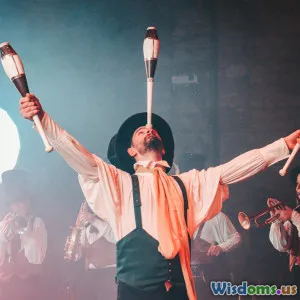
What Makes a Broadway Revival Succeed or Fail
10 min read Explore the critical elements behind the triumphs and pitfalls of Broadway revivals and what determines their fate on the iconic stage. (0 Reviews)
What Makes a Broadway Revival Succeed or Fail
Broadway revivals carry with them a unique blend of nostalgia and expectation. They revisit beloved works, offering audiences a chance to relive iconic stories or discover them anew through fresh eyes. But despite the immense groundwork laid by original productions, not all revivals soar to success; some falter spectacularly. What truly separates the triumphant revivals from the catastrophic ones? In this article, we'll delve into the nuanced elements that determine the fate of a Broadway revival.
Introduction
A Broadway revival doesn't merely repeat an earlier triumph — it reinterprets, recontextualizes, and reintroduces a story to a different generation and set of audience sensibilities. While the name of the original production can draw audiences, this alone cannot guarantee success. Theatergoers today look not just for familiarity, but also relevance and craftsmanship.
The stakes are high. Revivals account for a significant portion of Broadway productions; just in the 2018-2019 season, about 32% of shows classified as revivals. They come with inherent expectations, balancing the respect due to the original and the need to innovate. With production costs, star salaries, and theater rental fees often ballooning, a revival's success or failure impacts investors, artists, and the industry at large.
Key Factors in a Broadway Revival's Success or Failure
1. Casting Choices: The Magnetic Power of Stars and Fit
Casting is arguably the most tangible decision impacting a revival’s trajectory. The right casting can attract audiences and breathe new life into a familiar story.
-
Star Power: Well-known performers often act as box office magnets. For instance, the 2015 revival of "The King and I" starred Kelli O'Hara and Ken Watanabe, both acclaimed actors who brought gravitas and charm, drawing diverse audiences.
-
Character-Actor Fit: More critical than celebrity is authentic casting. The 2017 revival of "Sunday in the Park with George," starring Jake Gyllenhaal, was praised for his nuanced performance that deepened the show's emotional impact.
Conversely, miscasting can alienate audiences, diminish storytelling, and generate negative reviews, evident in some revivals that failed to capture the original show’s spirit.
2. Directorial Vision: Balancing Fidelity and Innovation
A director’s interpretation frames the entire production. Successful revivals often marry respect for the original with innovation to offer fresh perspectives.
Take the 2014 revival of "Pippin," directed by Diane Paulus, which creatively blended circus elements and audience interaction, resulting in a unique experience that delighted both critics and the audience. Its Tony Award wins reinforced how innovative direction leads to commercial and critical success.
On the other hand, overly traditional or uninspired direction can render revivals stale. The 2016 revival of "Shuffle Along" struggled partly because underwhelming direction failed to adequately update its themes for modern audiences, leading to mixed reviews.
3. **Design and Technical Elements: Visual Storytelling Matters
Production design anchors a revival in its era while also reflecting the contemporary lens of interpretation. Lighting, sets, costumes, and sound contribute significantly to the audience's immersion.
The 2017 revival of "Hello, Dolly!" starring Bette Midler excelled in lavish costume design and vibrant staging that conveyed the show's celebratory spirit, contributing to its box office longevity.
Alternatively, minimal or outdated design choices can make a revival feel dull or inaccessible. A Broadway revival must balance the nostalgia of the original aesthetic with modern tastes and technology.
4. Cultural Context and Relevance: Timeliness Speaks Volumes
Revival success often hinges on how well the show resonates with contemporary social and cultural themes.
For example, the 2017 revival of "Falsettos" struck a poignant chord as it revisited themes of family and AIDS awareness during a time when those topics were increasingly visible in public discourse.
Failing to adapt or contextualize such themes can alienate audiences. The 2018 revival of "Carousel" faced criticism for its handling of dated gender roles, which contrasted starkly with modern sensibilities, dampening its reception.
5. Marketing Strategies and Audience Engagement
An effective marketing campaign is indispensable. It needs to convey why the revival matters now and why people should invest their time and money.
Producers of the 2019 revival of "Oklahoma!" used innovative digital advertising and behind-the-scenes features to emphasize the show's updated choreography and modernized storytelling, successfully broadening their audience.
Failing to connect with target demographics, especially younger theatergoers, can doom revivals to obscurity even if the production itself is strong.
Case Studies: Lessons from the Stage
The Glory of "West Side Story" (2020 Revival)
The 2020 revival of "West Side Story" (though delayed) had promising elements: a refreshed choreography by Ann Reinking, authentic casting reflecting the show's cultural roots, and Stephen Sondheim's celebrated score. The anticipation stemmed partially from nostalgia but also a desire to see a classic reinterpreted responsibly. Its success demonstrates that honoring a work’s essence while integrating inclusive casting and sensitivity can lead to broad acclaim.
The Shortfall of "Miss Saigon" (2017 Revival)
The 2017 revival of "Miss Saigon" struggled with controversy surrounding cultural stereotypes and casting practices. Criticisms about the portrayal of Asians and gender roles impeded its resonance, illustrating that ignoring evolving audience values can hinder revivals, no matter the scale of production.
The Triumph of "The Color Purple" (2015 Revival)
This revival inspired by the 1985 original became one of Broadway’s longest-running revivals of the decade. With a strong cast (including Jennifer Hudson), updated arrangements, and an emotionally raw performance, it ensured relevance and attracted diverse audiences. It reaffirmed that thoughtful revival production—respecting cultural heritage while refreshing the material—can create enduring success.
Measuring Success Beyond the Box Office
While ticket sales are a clear metric of success, revivals can have value in broader terms:
- Critical Reception: Positive reviews can lift a show’s profile and extend its run.
- Awards: Tonys and Drama Desk Awards can recognize excellence and encourage further viewership.
- Audience Impact: Revivals can influence cultural conversations and inspire new generations of theatergoers.
The commercial viability often aligns with artistic success, but in some cases, a revival’s lasting legacy on art and culture outshines its immediate financial return.
Conclusion
Broadway revivals are inherently complex ventures — their success is not guaranteed by the pedigree of a beloved original. Instead, success stems from carefully balancing homage with innovation, making savvy casting decisions, integrating contemporary relevance, and designing immersive presentations.
Producers and creatives must remember that audiences today crave authenticity, relevance, and artistry as much as nostalgia. Failures often stem from misreading these values or complacency.
Understanding what makes a revival succeed or fail empowers theater professionals to rejuvenate timeless works for generations to come, sustaining Broadway’s vibrant legacy.
The future of Broadway revivals hinges on respect for history blended with creative courage and cultural consciousness. When these elements align, the curtain rises to thunderous applause and enduring acclaim.
Whether you're an artist, producer, or theater lover, recognizing these dynamics refines how we appreciate revivals — not simply as repeats, but as renewed celebrations of storytelling mastery.
Rate the Post
User Reviews
Popular Posts

















